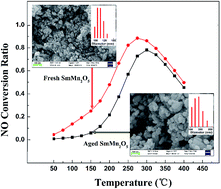Hydrothermal aging tests are important to carry out when evaluating the hydrothermal durability of heterogeneous catalysts in vehicle exhaust emission. Here, we explored the effect of aging on an efficient Mn-based mullite catalyst (SmMn2O5) of NO oxidation. The mullite catalyst was prepared via the hydrothermal method and was subsequently aged in air with a 10% H2O stream at 750 °C for 16 hours. The fresh and aged catalysts were structurally characterized using Powder X-ray diffraction(XRD), Raman, X-ray photoelectron spectroscopy (XPS), scanning electron microscope (SEM), high resolution-transmission electron microscope (HR-TEM), Brunauer–Emmett–Teller (BET) and temperature programmed desorption (TPD). For the performance evaluations, the samples were placed into a U-shape reactor furnace, and NO and NO2 concentrations were in situ recorded with an NOx analyzer. In contrast to fresh mullite, the aged sample showed a 25 °C higher light-off temperature and 11% conversion loss at its maximum conversion temperature of 300 °C. O2-TPD of the aged sample displayed a large decrease of the desorption area, consistent with an ∼3-fold loss of the BET specific surface area. Moreover, HRTEM, XPS and Raman spectroscopy results together indicated that a small portion of the mullite decomposed into perovskite SmMnO3 and Mn2O3, which further reduced the total quantity of Mn active sites. The reduction of the BET surface area and mullite decomposition together caused the decrease of the catalytic performance. We therefore expect maintaining the specific surface area to be important for preventing the loss of catalytic performance during the hydrothermal aging process.
